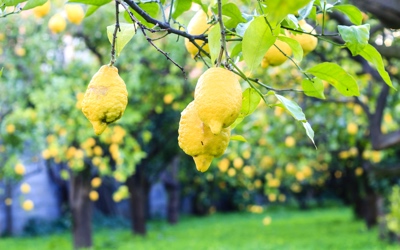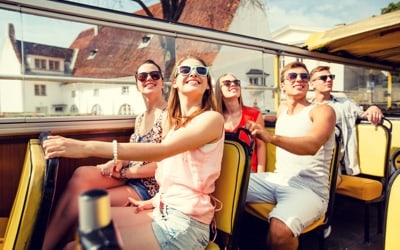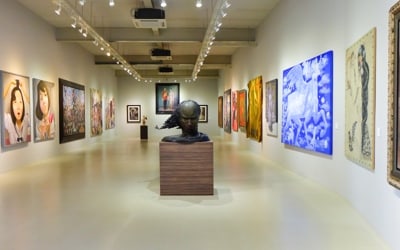
Royal Palace of Naples Entrance Ticket
1 h
Billete
Acerca de esta actividad
In the early 1600s, the Spanish Viceroys of Naples decided to build a modern residence for themselves and for when the King of Spain came to visit. Its open colonnades and loggias were very different in design from the magical fortified castles of the Angevin and Aragonese kings.
The site chosen for the palace was next to the Castel Nuovo at the end of Via Toledo, towards the new residential area of Chiaia, south west of the original old city center. Viceroy Ferdinando Ruiz de Castro, Count of Lemos and the vicereine Caterina Zonica de Castro commissioned Domenico Fontana to design and build the palace according to a model dating from the late Renaissance. The architect had already experimented with this model in Rome in the work commissioned by Pope Sixtus V.
The facade was built in brick and black Piperno stone. Its size reflects the manneristic tendencies of the time, while its decorative style is reminiscent of ancient Roman buildings, with its granite columns, Latin inscriptions, Doric, Ionic and Corinthian pediments and pilaster strips.
The inside of the palace is laid out around the square courtyard of honor, which in turn is surrounded by a colonnade of Piperno stone arches. Above this colonnade there is a loggia, a covered arcade linking up all the rooms. Already present in Fontana's original design, and also included in the subsequent extensions by Sanfelice, Vanvitelli, Fuga, and Gaetano Genovese, two other rectangular courtyards, the Belvedere Courtyard and the Coaches Courtyard, communicate with the courtyard of honor. These create an interesting visual effect seemingly extending into the infinite, with aligned porches and repeating architectural features.
The garden and the whole north-east face of the Palace with the Royal Theater of San Carlo and the stables are surrounded by 19th century iron railing. The entrance to the old riding ground is dominated by the iron sculptures of two "horse trainers" by Clodt von Jurgenburg, a gift to King Ferdinand II of Bourbon from the Tzar of Russia in 1846.
The esplanade facing towards Mount Vesuvius is connected to the bastions of the Maschio Angioino castle by an arched bridge built by the Viceroys, and recalls the old link between the Palace and the Fortress with its artillery arsenal.
In its early days of production, the Bourbon porcelain factory was located in a nearby pavilion. The entire Palace used to buzz with activities related to court life - such as the Royal Print Works, the Royal Tapestry Factory, which was later transferred to San Carlo alle Mortelle, the 17th century Palatine Academy, the Royal Chapel, the Court Upholsterers, the Military Guard, the Head Butler's rooms, and the staff quarters.
Leer más
Mostrar menos
The site chosen for the palace was next to the Castel Nuovo at the end of Via Toledo, towards the new residential area of Chiaia, south west of the original old city center. Viceroy Ferdinando Ruiz de Castro, Count of Lemos and the vicereine Caterina Zonica de Castro commissioned Domenico Fontana to design and build the palace according to a model dating from the late Renaissance. The architect had already experimented with this model in Rome in the work commissioned by Pope Sixtus V.
The facade was built in brick and black Piperno stone. Its size reflects the manneristic tendencies of the time, while its decorative style is reminiscent of ancient Roman buildings, with its granite columns, Latin inscriptions, Doric, Ionic and Corinthian pediments and pilaster strips.
The inside of the palace is laid out around the square courtyard of honor, which in turn is surrounded by a colonnade of Piperno stone arches. Above this colonnade there is a loggia, a covered arcade linking up all the rooms. Already present in Fontana's original design, and also included in the subsequent extensions by Sanfelice, Vanvitelli, Fuga, and Gaetano Genovese, two other rectangular courtyards, the Belvedere Courtyard and the Coaches Courtyard, communicate with the courtyard of honor. These create an interesting visual effect seemingly extending into the infinite, with aligned porches and repeating architectural features.
The garden and the whole north-east face of the Palace with the Royal Theater of San Carlo and the stables are surrounded by 19th century iron railing. The entrance to the old riding ground is dominated by the iron sculptures of two "horse trainers" by Clodt von Jurgenburg, a gift to King Ferdinand II of Bourbon from the Tzar of Russia in 1846.
The esplanade facing towards Mount Vesuvius is connected to the bastions of the Maschio Angioino castle by an arched bridge built by the Viceroys, and recalls the old link between the Palace and the Fortress with its artillery arsenal.
In its early days of production, the Bourbon porcelain factory was located in a nearby pavilion. The entire Palace used to buzz with activities related to court life - such as the Royal Print Works, the Royal Tapestry Factory, which was later transferred to San Carlo alle Mortelle, the 17th century Palatine Academy, the Royal Chapel, the Court Upholsterers, the Military Guard, the Head Butler's rooms, and the staff quarters.
Incluido
- Guaranteed to skip the long lines
- temporary exhibition fee
- Entry/Admission - Palazzo Reale
- Guaranteed to skip the lines
No incluido
- Food and drinks
- Hotel pickup and drop-off
- Transportation to/from attractions
- Meeting point
Adicional
- Confirmation will be received within 48 hours of booking, subject to availability
- Not wheelchair accessible
- Reduced Price Tickets and Free Tickets can only be obtained directly at museums and monuments in Naples
- You must print and present Weekend in Italy confirmation voucher in order to redeem your tickets at the moment of the visit
- The time you select on the order form is your preferred time. The museum or attraction will automatically confirm the closest available time, which can be anytime during opening hours on the selected date, if your preferred time is no longer available
- Stroller accessible
- Near public transportation
- Most travelers can participate
- PLEASE DO NOT USE THIS VOUCHER TO GAIN ACCESS TO THE MUSEUM
- This tour/activity will have a maximum of 15 travelers
Características
Cultural
90%
Turismo
65%
Original
40%
Puede ser que también le guste









 Ver todo 25 Colecciones
Ver todo 25 Colecciones
Haga clic para descubrir otras experiencias
Ver todo

Colecciones
Pompei
183 Actividades

Colecciones
Paestum
6 Actividades

Colecciones
Other trips
19 Actividades

Colecciones
Airport & Private transfers
11 Actividades

Colecciones
Sorrento
77 Actividades

Colecciones
Vesuvius mount
57 Actividades

Colecciones
Amalfi coast
141 Actividades

Colecciones
City tour
71 Actividades

Colecciones
Capri
55 Actividades

Colecciones
Hop-on Hop-off
6 Actividades






